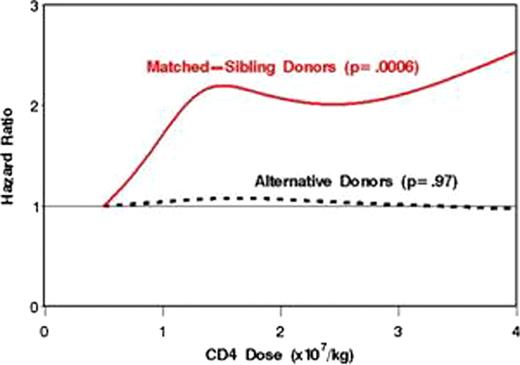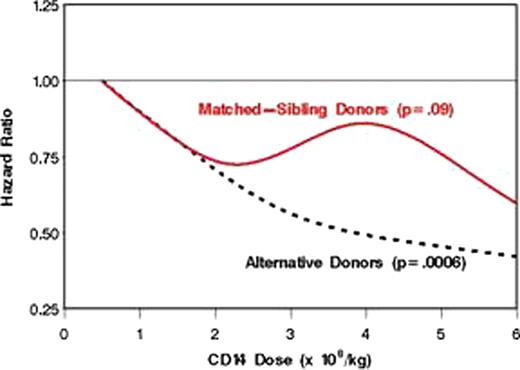Abstract
Abstract 676
We investigated the relationship of PBSC graft composition on GVHD and survival in 2,350 allogeneic transplant recipients from a single institution. Characteristics of the cohort included: median age: 50 (0.5-79); disease risk: low 12%, intermediate 41%, high 35%; HLA-matched sibling donor 53% and reduced-intensity conditioning 36%. Graft composition cell subsets included stem/progenitors (CD34+), monocytes (CD14+), B (CD20+), NK (CD3-CD56+), NK/T (CD3+CD56+), dendritic cell subsets (DC1 and DC2), and T-cell subsets (CD3+CD4+, CD3+CD8+, Memory, Naïve, Regulatory), measured by multicolor FACS analyses and expressed as infused cell subset/kg of actual recipient weight. Cell doses were modeled as continuous linear variables, by quartiles, or by cubic splines (allowing for non-linear models).
In contrast with previous findings, increasing CD34+ cell dose was not statistically associated with acute GVHD (p=0.49), chronic GVHD (p=0.91) or survival (p=0.74). However, several other cell subsets showed important associations. Shown in Figure 1 is a cubic spline graph of the hazard ratio (HR) of chronic GVHD as a function of CD3+CD4+ T-cell dose relative to a relatively low dose of 0.5 × 107/kg.
A strong association between CD4 T-cells and chronic GVHD was found in HLA-matched sibling donor recipients (p <0.001) but not for recipients of alternative donors. Among patients who received reduced-intensity conditioning and PBSC from a matched-sibling donor, higher CD4 dose was strongly associated with more chronic GVHD (p=0.001) with HR of 2.43 for quartile 4 (Q4) vs. quartile 1 (Q1) (p=0.002). We found no association between CD8 cell dose and chronic GVHD.
A strong association between CD4 T-cells and chronic GVHD was found in HLA-matched sibling donor recipients (p <0.001) but not for recipients of alternative donors. Among patients who received reduced-intensity conditioning and PBSC from a matched-sibling donor, higher CD4 dose was strongly associated with more chronic GVHD (p=0.001) with HR of 2.43 for quartile 4 (Q4) vs. quartile 1 (Q1) (p=0.002). We found no association between CD8 cell dose and chronic GVHD.
A highly significant correlation was found between larger doses of CD14+ monocytes and less chronic GVHD (p<0.001). Figure 2 displays the HR results compared to a dose of 0.5 × 108 CD14 cells/kg, indicating a strong association in the alternative donor setting (p<0.001: by quartile analysis HR=0.59 for Q4 vs. Q1; p=.0004), and remained a suggestive trend in the matched sibling group. For the overall mortality analysis, several cell subsets showed significant associations. Patients receiving higher doses of NK cells had lower survival (p=0.007). Higher doses of memory CD4 was also found to be associated with lower survival, but the effect appeared to be restricted to the matched-sibling donor group (p=0.007). Increasing doses of DC1 were also associated with worse survival (p=0.02) for both reduced intensity and ablative conditioning groups, although the dose response was stronger in the ablative group (HR=1.17 Q4 vs. Q1). In contrast, higher doses of with NK/T cells correlated with lower mortality (p=0.01) but only in the matched-sibling group (Q4 vs. Q1, HR=0.78, p=0.05).
In this large, single center study, no associations of CD34 cell dose with GVHD or overall mortality were found. Further, our results suggest that previously reported associations between T cell dose and chronic GVHD are primarily driven by CD4 content in PBSC, and restricted to the matched-sibling donor (Figure 1). The lack of correlation with alternative donors may reflect differences in T-cell responses to the greater minor histocompatibility divergence with alternative donors, or changes in donor T-cell functionality associated with the higher dose of G-CSF (16 μg/kg/day) used for sibling donor mobilization at our center. To our knowledge, the correlation of higher CD14 dose with a reduced incidence of chronic GVHD is a novel finding, perhaps reflecting the known shift to a more immunosuppressive function of monocytes after G-CSF exposure. Similarly, reduced survival associated with higher doses of NK, memory CD4, and DC1 cells, and improved survival with greater numbers of NK/T cells represent new findings that will require additional analyses. Altogether, these correlations of GVHD and mortality with PBSC cell subsets support the concept that engineering of grafts could result in improved outcomes with allogeneic transplantation.
No relevant conflicts of interest to declare.
Author notes
Asterisk with author names denotes non-ASH members.



This feature is available to Subscribers Only
Sign In or Create an Account Close Modal